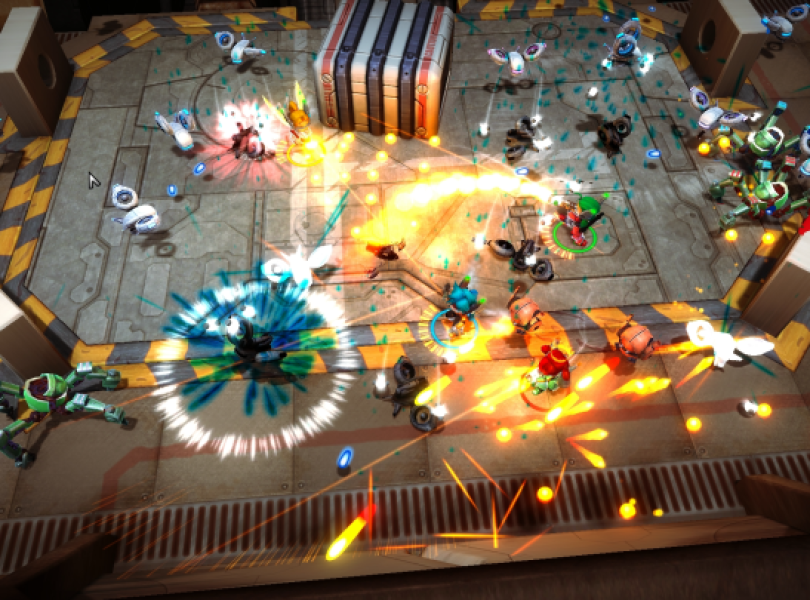Assault on the senses.
By Cam Shea
The enemies swarm in from all sides, leaving me frantically back-pedalling, staying just ahead of the pack as I blast them in the face, whirling to pick off enemies that pop up behind. When a big brute appears or the knot of robots grows too thick, I switch to my flamethrower to quickly drop anything in its path. The enemies are coming faster and faster, but thankfully my machine gun is ramping up too, soon helped along by a power-up that positions twin drones on either side of me. Bring it on! I think, sending a thick stream of pulsing gunfire blazing across the screen.
Assault Android Cactus (AAC) is a slick twin-stick shooter that knows how much fun it is to wield spectacular firepower. It’s also a game that understands that depth and difficulty are not necessarily the same thing. AAC is immediately accessible and thoroughly conquerable for an average player, but with extended play it also reveals a challenging end-game for high score chasers.
Initially though, you’ll likely be so enamoured by the intensity of the action and the variety in the level design to care too much about your score. In one level the floor might reconfigure itself under your feet, in another a series of conveyor belts conspire to tug you towards mobs of robots.
Enemy composition grows ever more complicated too, steadily introducing new foes – Buster Titans that leap at you, Fetcher Fidos that can tether you to the spot, Reaper Spectres that teleport in en masse and charge up powerful laser attacks – which must be prioritised and dispatched accordingly. The bigger guys are bullet sponges too, so unless your primary attack is powered all the way up – by collecting energy orbs that felled enemies drop – you’ll need to use your secondary weapon, which (mostly) operates on a cool-down system.
Each of the nine playable characters has a unique loadout, encouraging you to play to her strengths. Holly, for instance, has homing bullets, which aren’t all that powerful but help her maintain kill combos more easily than some characters, while her secondary is an energy cannonball that slowly travels across the screen but does a lot of damage. Starch, on the other hand, has a laser beam primary that does more damage the closer you are to an enemy, but requires more precision. She can unleash a barrage of rockets with her secondary fire.
Experimenting with the many characters – and seeing how familiar levels play out with a different android – is a big part of the appeal here. It also helps ensure AAC doesn’t get too frustrating. One sub-boss I was having trouble with, for instance, is able to dash to your position and knock you down in an instant, but once I realised that Starch’s secondary fire could shoot around the thick columns in the level, I realised I could keep a column between us and take the boss down from a distance.
If you’re looking for something a little different Assault Android Cactus has you covered, too. Peanut, for instance, shoots molten metal as her primary (leaving the ground burning for a short while), but also has a drill attack that sees her fly across the screen, driving the first enemy in her path back and into a wall. This can be a great way to get out of trouble or collect a distant battery that’s about to expire.
Aubergine is even more distinct. Instead of wielding a gun, players guide a robot drone, which is controlled independently, while she can also drop mini black holes for crowd control. Coral also allows for some cool strategies, with a wide shotgun spread main attack and a plasma field that does damage and repels enemy projectiles for her secondary.
When – and how – you use each character’s secondary attack is a vital part of AAC’s learning curve. Not only are they necessary for quickly dispatching bigger enemies – and groups of enemies – but you also do a dodge when switching from main to secondary, so using your secondary can keep you alive when timed well, as can picking up the right power-up.
We want to hear it.
Developer Witch Beam has done a superb job ensuring that Assault Android Cactus will be a blast for players of almost any skill level. Unlike the bullet hell shooter genre that it clearly takes inspiration from, you don’t have to possess a savant-like ability to weave through gunfire to survive. Get hit a handful of times and you’ll be knocked down, but you can quickly recharge your android and be back on your feet with no significant penalty other than some lost time. You’ll only fail a level if you run out of power, in fact, so nabbing battery top-ups when they drop is crucial for beginners.
Once you have the basics down, you can start trying to improve your score and rank for each level, which is very much AAC’s end-game, and the difference between A, S and S+ is enormous. Getting an S rank, for instance, means beating a level without a single knock-down. S+ equals no knock-downs and killing every enemy in one unbroken chain. That means you can’t have a gap of more than two seconds between kills… so even switching between your primary and secondary weapon at the wrong time can actually end your kill streak for some characters, turning that powerful alternate weapon into a potential liability.
And then there’s maximising your score on top of an S+ rank, which is a whole other thing. Suffice to say, the skill and knowledge cap on Assault Android Cactus is very high for those that want to max out what’s possible.
Even if you’re not interested in advanced play and battling for contention on the leaderboards, there’s plenty to keep you coming back, even after you’ve beaten the final boss. Co-op for up to four players is every bit as intense as you’d expect, while the additional modes are great. Boss Rush chains all the boss encounters together, Infinity Drive pits you against never-ending waves of enemies and Daily Drive offers up a unique challenge each day that can only be attempted once.
There also a number of bonuses that can be purchased with game credits, such as a first person mode, a cool isometric viewpoint, a variety of visual filters, alternative secondary weapons based on each character’s primary and – in a nod to the days when games had cheats – the ability to “subject the androids to the indignity of regular human proportions,” aka Normal Sized Head Mode.
Assault Android Cactus is an energising shooter experience. Each level, character and enemy brings something fresh to the game, and the end result is chaotic, polished, packed with variety and effortlessly charming. I had a huge amount of fun just trying to top my own high scores and experimenting with the different protagonists, let alone making an impact on the global leaderboards, so it really does feel like there’s something for everyone.








